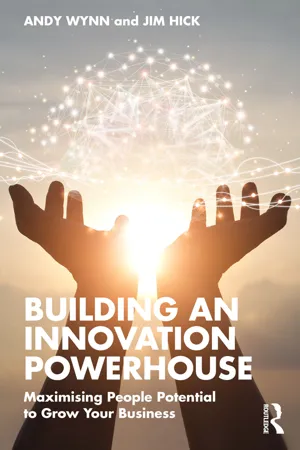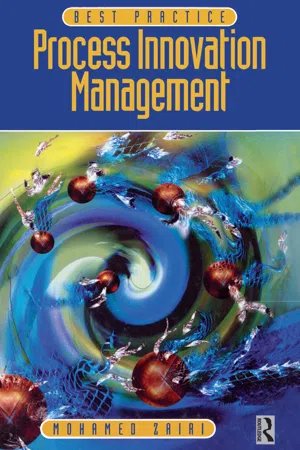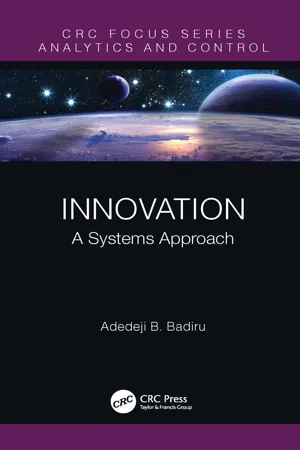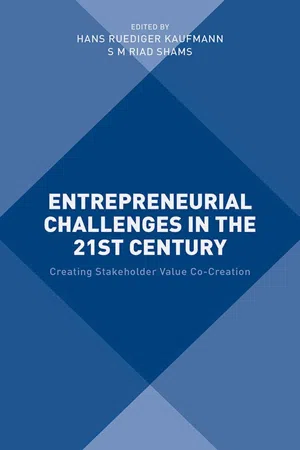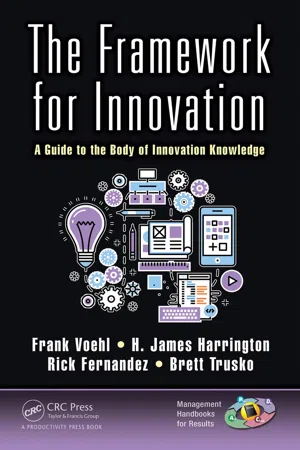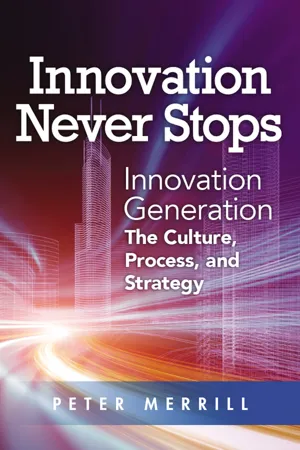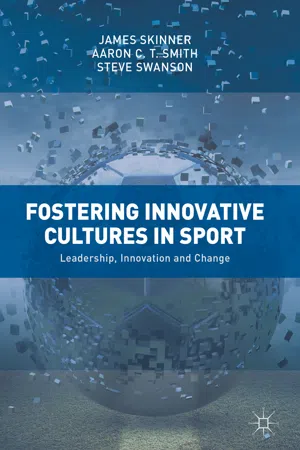Business
Innovation Culture
Innovation culture refers to the environment within a company that encourages and supports creativity, risk-taking, and the development of new ideas and solutions. It involves fostering a mindset that values experimentation, continuous improvement, and learning from failure. A strong innovation culture can drive business growth, competitiveness, and adaptability in a rapidly changing market.
Written by Perlego with AI-assistance
Related key terms
Related key terms
1 of 4
Related key terms
1 of 3
11 Key excerpts on "Innovation Culture"
- eBook - ePub
Building an Innovation Powerhouse
Maximising People Potential to Grow Your Business
- Andy Wynn, Jim Hick(Authors)
- 2022(Publication Date)
- Routledge(Publisher)
But culture is also a living thing, just like the people that create it, it develops, it grows and it evolves as new employees start, or people leave, as new strategies are announced, new organisational structures are rolled out and new projects and initiatives are started. All of these things change the nature of the people that form the culture and change the context within which the culture exists. And in just the same way that the development of a person can be shaped, influenced and directed by training, role modelling and suggestion, whether positively or negatively, so a company’s culture can be developed and directed, by reorganising reporting structures, terms and conditions of employment, incentives, and a thousand other things. Yet without a clear sense of where you are as a business and where you want to be, and without a plan of action to guide culture in the direction that will contribute positively to the future, all your actions as management will only serve to push and pull the culture in different directions, however well-meaning the decisions you make and act upon, leading to ambiguity and confusion for many employees in your business.So given this context of what culture means in terms of business, an Innovation Culture therefore describes the specific facet of the overall culture that is focused on promoting innovation within a company. Though I refer you back to the importance of first defining what innovation means to your business to avoid ambiguity and misinterpretation. If you have taken note of the previous two books in this series, then you should appreciate that for a business to grow through innovation, it needs an end-to-end innovation process in place that involves all departments, and an organisation that brings all functions into play to deliver on the processes, and therefore the Innovation Culture should truly span right across the organisation in a way that shapes and influences all those attitudes, behaviours and ways of working together that are woven into the culture, such that all employees want to contribute positively. This is critical for success because whilst the innovation processes give people the tools and the organisation sets the right environment it is the culture that makes people want to take part and deliver. - eBook - ePub
Leading and Transforming Organizations
Navigating the Future
- Kumaran Rajaram(Author)
- 2023(Publication Date)
- Routledge(Publisher)
Chapter 2 Value Creation Innovative Culture DOI: 10.4324/9781003286288-3 Organizations must advocate, and ingrain values that shapes an innovative culture with an outcome-based approach. They need to recruit talents that have such intrinsic motivation and values, but beyond that to comprehend the nuances to create the eco system and operational structure that inspires them to create the recurring value-creation effect. Kumaran Rajaram, PhD 2.1 Introduction Organizations pursue varying different forms and types of innovations. These innovations could be with regard to their products or services, internal processes, and business models, among other aspects (Purcell, 2019). Innovations remain essential for organizations today that exist in highly volatile environments. If companies do not embrace innovation and change, they will struggle to stay afloat with the rapidly changing and VUCA (volatility, uncertainty, complexity, and ambiguity) external environments. Convincingly, innovation brings plenty of benefits to the organization. The innovations serve as a means of growth, keep organizations relevant, and provide ways for them to differentiate themselves. Hence, an innovatively rooted culture is vital for organizations to build on. Innovation Culture is defined as a multi-dimensional context that includes the intention to be innovative, the infrastructure to support innovation, operational level behaviors necessary to influence a market and value orientation, and the environment to implement innovation (Dobni, 2008). Successful organizations have the capacity to incorporate innovation, its practices into the organizational culture and management processes of the organization. In a nutshell, an Innovation Culture could potentially bring about varying benefits for an organization. 2.2 Innovative Culture Further to that, an innovative culture drives an outcome-based approach to value creation - eBook - ePub
- Mohamed Zairi, Richard Duggan(Authors)
- 2010(Publication Date)
- Routledge(Publisher)
Chapter 3 , section ‘From idea to implementation’). Most large companies deploy some variation of a structured methodology. The third stage is commercialization, where the idea becomes operational. In others words, the product is produced so as to allow extraction of value from all that has been created in the earlier phases.Although innovation cannot be smelt, touched, heard, tasted or seen, it can be sensed. It is probably best described as a pervasive attitude that allows a business to see beyond the present and create the future. Innovation is the engine of change and in today's fiercely competitive environment, resisting change is dangerous. Companies cannot protect themselves from change regardless of their excellence or the vastness of their current resource basin. While change brings uncertainty and risk, it also creates opportunity and the key driver of the organization's ability to change is innovation. However, simply deciding that the organization has to be innovative is not sufficient; that decision must be backed by actions that create an environment in which people are so comfortable with innovation that they create it.Culture is a primary determinant of innovation. The possession of positive cultural characteristics provides the organization with the necessary ingredients to innovate. Culture has multiple elements that can serve to enhance or inhibit the tendency to innovate. Moreover the culture of innovation needs to be matched against the appropriate organizational context. To examine culture in isolation is a mistake, and to simply identify one type of culture and propose it as the panacea to an organization's lack of innovation is to compound that mistake.Innovation Cultures and innovation climates
Visiting organizations such as 3M, Hewlett Packard, Sony, Honda and The Body Shop leaves one with a feeling not often encountered in ordinary companies. This ‘feeling’ often defies definition, yet despite its intangibility, contains organizational concreteness as real as the machinery on the shop floor. This feeling is usually found rooted in the prevailing psyche of each organization. A company such as 3M feels dynamic, while some of its counterparts feel rather staid and unexciting. The feel of the organization reflects both its climate and culture. - eBook - ePub
Innovation
A Systems Approach
- Adedeji B. Badiru(Author)
- 2020(Publication Date)
- CRC Press(Publisher)
BusinessWeek , 2007), is considered a premiere leader in the development of the breakthrough spirit. With the recent emphasis being placed on innovation throughout the business world, it is not surprising that hundreds of articles and publications have been written on the characteristics of an innovative culture. Several common threads appear within the leading studies that help define the key characteristics: strong customer focus, collaboration, effective processes, creative people, inspiring leadership, risk-taking, and motivation/reward systems.- The right organizational structures
- The right processes
- The right people
- Inspired leadership
- Orchestration from the top
- Collegial culture with individual rewards
- Consistent business and technology integration
- Customer focus
- Teamwork and collaboration with others
- Appropriate resources
- Organizational communication
- Ability to select the right ideas for research
- Ability to identify creative people.
Strong Customer Focus
The research suggests that organizations who place their existing and future customers at the forefront tend to be more innovative. Strong customer focus does not just mean delivering what customers ask for but rather “capturing their ideas or actually allowing them to innovate on their own behalf” (American Management Association, 2006). According to Kelley and Littman (2001), co-founder of IDEO, true understanding comes not by talking to customers but by watching them and becoming immersed in their environment. As a result of this strong customer focus, organizations are in a better position to implement disruptive product and process innovations that transform the marketplace and decimate the competition. Demonstrating this point, Christensen and Raynor (2003) reviewed the extensive market analysis conducted by a quick-service restaurant chain with regard to milkshake sales. The group examined not just what the customers wanted, but why they wanted it, when they wanted it, who they were with, and what they would be doing if they were not there buying a milkshake. They essentially focused on the job the customer was trying to get done. - eBook - ePub
Entrepreneurial Challenges in the 21st Century
Creating Stakeholder Value Co-Creation
- S M Riad Shams, Hans Kaufmann(Authors)
- 2016(Publication Date)
- Palgrave Macmillan(Publisher)
An enterprising culture is a basic prerequisite for developing conditions that would lead to serial entrepreneurship and foster entrepreneurial capabilities, which ensure constructive economic performance for an organization. Although related empirical research is very limited and the link is understudied, Hogan and Coote (2014) state that an enterprising culture favors firm performance by fostering innovative behaviors; through favoring the development of innovative products and services and the generation of novel solutions, it brings about positive performance outcomes (Storey and Kahn, 2010; Ettlie and Rosenthal, 2011). It facilitates the acquisition of certain entrepreneurial skills required by the modern workplace: creative and innovative problem solving, readiness for change, open-mindedness, opportunity recognition and utilization, risk-taking and self-confidence (Kwong et al., 2012). An enterprising culture favors the creation of a working environment in which personal advancement and business growth are pursued through regular generation, diffusion and utilization of new knowledge and creative ideas as well as through systematic environmental scanning, opportunity seeking and the implementation of change. It is inseparably linked with alertness and strong motivation, networking and customer orientation, global thinking and experimentation (Dimitratos et al., 2010). An enterprising culture develops employee capacity for regular team learning and collective action to achieve organizational objectives and realize organizational vision. It promotes internal collaboration based on mutual trust and respect, a free flow of knowledge, an open exchange of information and transparent communication. It encourages openness to new ideas, welcomes difference, opinion diversity and disagreement, stimulates experimentation, risk-taking and innovation.Kaufmann et al. (2012) underline the fact that the creation of the appropriate corporate culture is a critical condition for successful innovation and sustainable entrepreneurship to be triggered and flourish. Innate talent and abilities may be under-utilized or totally “mutilated” in the case when individuals are not offered the opportunities required for detecting, cultivating and exploiting their abilities. In less affluent countries with below average economic performance and living standards, a lower tendency for innovation and entrepreneurial action has been identified (Hundley and Hansen, 2012). According to the GEDI Index 2014 (Global Entrepreneurship & Development Institute, 2014), the United States is ranked first of 121 countries in developing effective entrepreneurial attitudes, aspirations and activity, while Chad and Bangladesh rank last. This could lead someone to wonder what would have happened if Bill Gates, Michael Dell or Mark Zuckerberg had been born in Chad or Bangladesh instead of the United States. Hence, it seems that although talent is universal, stimulating opportunities are not. - eBook - ePub
- Jin Chen, Alexander Brem, Eric Viardot, Poh Kam Wong, Jin Chen, Alexander Brem, Eric Viardot, Poh Kam Wong(Authors)
- 2019(Publication Date)
- Routledge(Publisher)
Most researchers emphasise the importance of the organisational culture and climate for creating innovations. Stimulating innovative activity requires a specific organisational culture. The climate and innovative culture determine the creative possibilities of the organisation, because from them flows the inclination of employees to take innovative endeavours. Organisational culture is defined as a set of created norms developed on the basis of the assumptions, values, and norms of the models of operation, showing employees how to achieve the company’s goals. The basic cultural patterns conducive to innovation are openness to risk, change; willingness to experiment; tolerance of uncertainty; and the use of opportunities, creativity, trust, cooperation, mutual support and error tolerance. What is also important is the autonomy in action, validation, freedom to submit ideas, supporting new ideas, and tolerating discussions on the submitted ideas (Brilman, 2002, p. 172).Thus, in enterprises with an Innovation Culture, employees deal with uncertainty themselves, based on their own knowledge, skills, and experiences, and dynamic networks of cooperative ties are created.The innovative climate is focused on the development of employees, including the assessment of their qualifications, skills, and potential. An organisation with such a climate has a flexible organisational structure, where formalism and strict subjection to regulations and organisational procedures are reduced to a minimum. There is a cult of professionalism, risk tolerance, freedom in action, individualism, and permission to take risks and be innovative. Moreover, there is a large tolerance for errors, because it is thanks to them that the organisation can access new solutions. The goals of the organisation are treated by the employees as challenges (Ekvall and Ryhammar, 1999). The role of the management staff is to encourage and stimulate the employees to submit their own ideas for improving the work or products or services offered by the organisation. Non-formal channels of communication and free flow of information between employees and their superiors are also promoted. This is to enable employees to disclose and exploit their creative potential.Another factor that may increase the chances of building an efficient innovation team is trust. Trust is defined and interpreted in various ways in the literature. According to a psychological approach, it is a kind of mental state that is related to the willingness to take risks and accepting them. It can also mean being ready to be sensitive to the actions of the other party based on the belief that the other party has done specific actions important to the trusting party, which are independent of the ability to monitor and control. It is also readiness based on the assessment of the other party’s credibility in a situation of interdependence and risk. - eBook - ePub
The Framework for Innovation
A Guide to the Body of Innovation Knowledge
- Frank Voehl, H. James Harrington, Rick Fernandez, Brett Trusko(Authors)
- 2018(Publication Date)
- Productivity Press(Publisher)
50-question innovation audit and linked it to an Innovation Maturity Model from Karl T. Ulrich and Christian Terwiesch of Wharton Business School.A culture can have characteristics including, but not limited to • Creating and nurturing collaborative teams • Providing rewards and recognition that focus on a specific area such as innovation • Allowing for and supporting a self-managing culture • Displaying curiosity, courage, and level of risk allowedAn organization that realizes it needs to change its culture cannot simply fire everybody one day and instantly replace everyone with the right people the next day, even if it knows exactly what kind of people it needs. Culture change and adjustment takes time and patience. The last thing an organization should do is to make a speech discussing the need for new behaviors and then expect the culture to change overnight.This chapter focuses on how to successfully align the accountable organization’s attitudes, feelings, values, and behaviors with the needs of an innovation project. Whenever you have the idea that you want to convert to a successfully commercialized innovation, you need to evaluate your culture against the alignment of your people (skills), processes, tools, metrics, stakeholders and sponsors, management model, organizational structure, and reward and recognition mechanisms.Four key categories of activities in culture change are Vision, Motivation, Skills Development, and Implementation. The four key categories can be made into a matrix by coordinating with the phases of technology delivery known as initiate, customize, fan-out, and institutionalize. - eBook - ePub
Innovation Never Stops
Innovation Generation – the Culture, Process, and Strategy
- Peter Merrill(Author)
- 2015(Publication Date)
- ASQ Quality Press(Publisher)
The other process in which you can unknowingly undermine your culture is your recruitment process. An innovative organization embraces diversity. There is a tendency for us to recruit more of the same when we look for new people to join our organization, and we mirror the majority of our company population. Your recruitment focus should be on the values that matter in your culture. You must evaluate whether potential new people support those values and practice the behaviors you seek.When I joined the Research Division of the Courtaulds Corporation, the company had each potential employee spend three days in interviews. This was the way in which they ensured that new people had the right values. Compare this investment with the cost of labor turnover. Companies are often surprised that when they invest in only a one-hour interview, they also have high labor turnover.Key Points •Culture is “the way things get done around here.” •Strong culture means cohesive; weak cultures have variation. •Culture is based on values, or what is important. •Cultures such as “macho,” “work hard, play hard,” and the “process” culture do not support innovation. •An innovative culture has to be strong to be effective but must be based on unique values. •Behavior is based on values; innovative behaviors are exploration, observation, interaction, collaboration, and experimentation. •Embracing failure is a critical behavior. •Recognition endorses values and behaviors. •Values are maintained and strengthened through the performance review process and through a sound recruitment process. •In order to change to an innovative culture, an organization will need to go through a distinct change process. •The business leader has a key role in communicating values through a vision of innovation.12 Innovation TeamworkNo man is wise enough by himself. —PlautusA rugby team is really two teams: the forwards or “scrum,” which are eight “big guys,” and the backs - eBook - ePub
Emergent
Ignite Purpose, Transform Culture, Make Change Stick
- Stephen Scott Johnson(Author)
- 2017(Publication Date)
- Wiley(Publisher)
Equip teams with what they need to be self-motivated and self-directed. Collaboration should be informal and voluntary. Again, autonomy and interdependence is the catalyst.Don’t stem the exchange of ideas and insights
Build a comprehensive understanding of your environment by welcoming creativity and the exchange of knowledge, insights and ideas. The result is a common approach to communication and problem-solving, where people evolve together and design the right adaptations and solutions to known problems.Promote a shared vision
Organisations with a shared vision thrive more readily than those without one. Unite and inspire your people by helping them focus on their ‘business as usual’, while adapting together towards a mutually agreed higher-order purpose.Decentralise authority and decision-making
Remove the burden from business leaders by empowering staff with autonomy to make their own decisions. Doing so increases morale and gives employees more input in the overall direction of the organisation, allowing them to make better use of time, knowledge and experience to implement their own ideas.CURIOUS
Curiosity is a major indicator and influencer of success in work and life. While often lauded as a vital element of a thriving culture and of innovation (which it is), the intangible nature of curiosity makes it challenging for organisations to nurture it as a fundamental aspect of meetings and projects.Here are some ideas on how to do so.Encourage exploration and experimentation
Introduce fun into people’s ‘everyday’ to mitigate monotonous and uninspiring workflow and culture. Encourage a love of learning and introduce new practices and environments (that is, physical spaces) that challenge people to explore beyond ‘norms’ and imagine new experiences and possibilities. - eBook - ePub
Riding the Waves of Culture
Understanding Diversity in Global Business
- Charles Hampden-Turner, Fons Trompenaars(Authors)
- 2020(Publication Date)
- Nicholas Brealey Publishing(Publisher)
orientation to the person versus orientation to the task .These four metaphors illustrate the relationship of employees to their notion of the organization. Figure 18.1 summarizes the images these organizations project.FIGURE 18.1. Four Corporate CulturesSo the prerequisite for an innovative organization is the reconciliation of a variety of cultures in order to face the changing dynamic world in which the organization operates. Cultures can learn to reconcile differences in values at ever higher levels—for example, so that better rules are created from a variety of exceptions that come with growth. But let’s follow the typical life cycle of cultures.Typical Life Cycle of Corporate Cultures
Organizational culture is the result of the way the fight between competing values manifests. If one value dominates its opposite, you run a risk, as you are not addressing the value that is subjugated—for example, Do people prefer to meet deadlines for short-term results or give priority for a visionary long-term future? Do people take individual responsibility or rather share in teams? Once reconciled, we create a culture of innovation, since innovation essentially is to combine values that are not easily joined, and therefore scarce and profitable. So Apple has combined esthetics with functionality, and Formula I racing has combined safety with speed (better known as aerodynamics).Creative Entrepreneurship: Founders Know Everyone Personally
Typically organizations begin by the founders creating both a product (or service) and a market. As the organization grows, it exceeds the capacity of the founder to know everyone personally resulting in a crisis of leadership - eBook - ePub
Fostering Innovative Cultures in Sport
Leadership, Innovation and Change
- James Skinner, Aaron C. T. Smith, Steve Swanson(Authors)
- 2018(Publication Date)
- Palgrave Macmillan(Publisher)
2014 ). Of note is the way in which the pride gets expressed through a combination of monumental self-imposed team discipline, and an astonishing ability to capitalise upon opportunities. They can be steel and they can be water because the team has fostered a culture that leverages bounded innovation.As we have repeatedly argued, innovation thrives in fluid environments . But the trouble with fluid environments is that they can easily move into murky disorder where even the best innovations are overlooked, misunderstood, underemployed, or bungled. Innovations that cannot be controlled also cannot be scaled; they either never get off the ground, or remain confined to small-scale under-utilisation. However, sport enterprises do not just instantly develop innovative cultures , but they can take immediate steps to foster the conditions where innovation is more likely to emerge in a manageable form. This is where boundary conditions and ‘order-generating rules’ can prove advantageous.Order-generating rules are relevant to innovative culture because, by establishing a set of boundaries within which dynamic, innovation-conducive conditions can be safely induced, they provide structured flexibility whilst preserving relative order. For sport enterprises first venturing into innovation, this more measured approach offers an effective way of making progress without risking the usual inertia that comes from cultures resistant to new ways of doing things. Pockets of innovation can therefore be pursued without compromising the direction and stability of a sport enterprise’s general business . In a way, such pockets of innovation allow organisations to ‘sneak up’ on innovation by gradually building their cultural foundations. To use a physical metaphor, the ‘frozen’ order of walls and doors in an office gradually make a little room for the unpredictable interruption, distraction, conversation, and stimulation of open work areas. Continuing the metaphor where office walls and doors represent the conventional approach, and open spaces stand for innovation, it is easy to see how jumping too far and too fast from the former to the latter can lead to confusion and dysfunction. Instead, we propose that new projects are given the open space to ideate before returning to the steadfast offices of mainstream business
Index pages curate the most relevant extracts from our library of academic textbooks. They’ve been created using an in-house natural language model (NLM), each adding context and meaning to key research topics.
Explore more topic indexes
Explore more topic indexes
1 of 6
Explore more topic indexes
1 of 4
